Ready to take leg day to the next level and develop monster leg strength? Here are the best exercises for industrial-strength hamstrings plus two sample workouts to get you started.
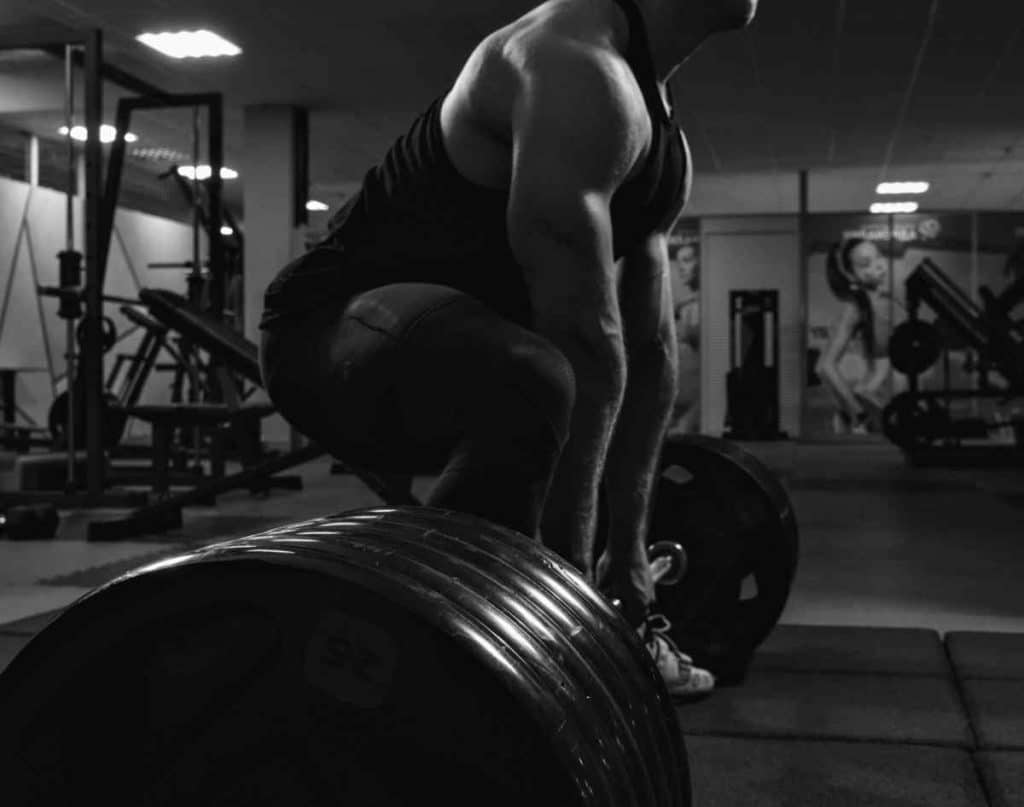
One of the muscle groups that lifters frequently ignore in the gym is the cables that run up and down the back of their legs…
The hamstrings. The hammies.
The emphasis tends to be on back squats, leg extensions, and hitting the leg press machine like it owes them money.
Unfortunately, neglecting the posterior leg muscles can lead to huge imbalances and weaker leg strength.
You are also leaving a TON of muscle development on the table by not investing time in your hamstrings.
- Benefits of Training Your Hamstrings
- The Best Exercises for Training Hamstrings
- ⭐ Hamstring Exercise #1: Romanian Deadlift
- ⭐ Hamstring Exercise #2: Glute Ham Raise
- ⭐ Hamstring Exercise #3: Lying Leg Curl
- ⭐ Hamstring Exercise #4: Dumbbell Good Morning
- ⭐ Hamstring Exercise #5: Stability Ball Curl
- ⭐ Hamstring Exercise #6: Single-Leg Stability Ball Curl
- ⭐ Hamstring Exercise #7: Kettlebell Swing
- ⭐ Hamstring Exercise #8: Kettlebell One-Legged Deadlift
- ⭐ Hamstring Exercise #9: Sumo Deadlift
- ⭐ Hamstring Exercise #10: Banded Hamstring Curl
- Two Sample 20-Minute Hamstring-Focused Workouts
- Hamstring Exercises – FAQs
In this guide, we’ll talk about why you should pay attention to your hamstrings, which exercises are the best for your hammies, and how to put them all together into a kickass 20-minute workout.
(Make that two sample workouts!)
We’ll finish off by answering some commonly asked questions to make sure you know everything you need to know to get a truly epic hamstring workout.
Let’s get to building those big cables on the back of your legs!
Benefits of Training Your Hamstrings
There are a few reasons you should invest the time into training your hamstrings nearly as much as your quads:
Improve Leg Strength
When you squat, lunge, or jump, your quads may end up doing a lot of the work, but not all the work. Your glutes and hamstrings also engage to generate power/force during the movement.
If you don’t have sufficient hamstring strength, you’ll be less effective at performing even these basic movements/exercises.
Greater Knee Resilience
The hamstrings help to stability your knee joint during lower body movement. Insufficient attention to your hamstrings will lead to higher risk of knee injuries because your quads will be over-sized and over-strengthened, with no posterior muscle to balance them out.
Increase Core Stability
Your hamstrings, glutes, and lower back all work together to bend, squat, lunge, and move efficiently.
Training these muscles improves your posture and increases the stability and strength in your core musculature, which means more resilience in your lower back and less likelihood of injury.
More Running Power
Your hamstrings play a significant role in your running movement—they’re what help you to decelerate rapidly, such as when slowing from a sprint when playing sports or sprint training.
Without sufficient hamstring strength, you won’t be able to safely slow down without risking injury to your leg muscles.
You’ll also be more prone to injury during high-velocity running because there is a degree of deceleration involved in every single step you take (necessary to maintain your balance and transition between feet).
Better Athletic Performance
Your hamstrings are necessary for stability in your hips and torso, climbing stairs, standing up and sitting down, lifting your legs, and bending over to lift heavy objects. Strong hamstrings will make you a better athlete overall!
As you can see, there are a lot of excellent reasons that you should be paying more attention to your hamstrings!
You can do that by incorporating the exercises below into your workout.
Your leg day routine should include at least 20 minutes to pay particular attention to your hamstrings (and glutes).
10 Killer Hamstring Exercises
⭐ Hamstring Exercise #1: Romanian Deadlift
Also known as the “stiff-legged deadlift”, the Romanian deadlift involves lifting heavy weights in the deadlift motion but keeping your legs as stiff as possible so your hamstrings do all the work.
Regular deadlifts allow for bent knees, which shifts the focus upward to the lower back (with some glute and hamstring engagement).
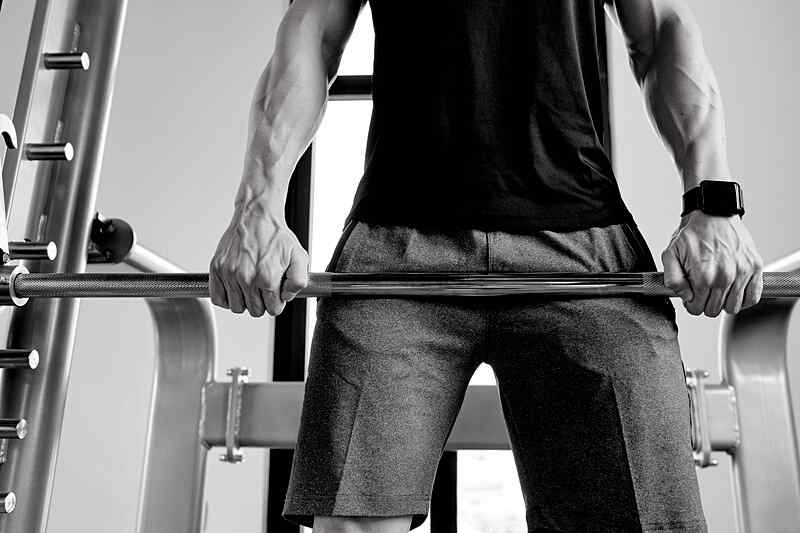
But by removing the bend from the equation, there is more hamstring engagement (with some glute and lower back) to ensure your hammies get all the focus!
To perform this exercise:
- Set up for a deadlift, with the barbell either resting on the ground or on a cradle (depending on your desired starting point).
- Grip the barbell in both hands and lift to standing position.
- Keep your legs as straight as possible (without locking out your knees) as you bend forward and lower the weight to the ground.
- Feel the burn in your hamstrings as you straighten back up to standing position.
- Thrust your hips forward to engage your glutes at the top.
- Repeat as desired.
⭐ Hamstring Exercise #2: Glute Ham Raise
The glute ham raise is an exercise that engages both the glutes and the hamstrings very effectively!
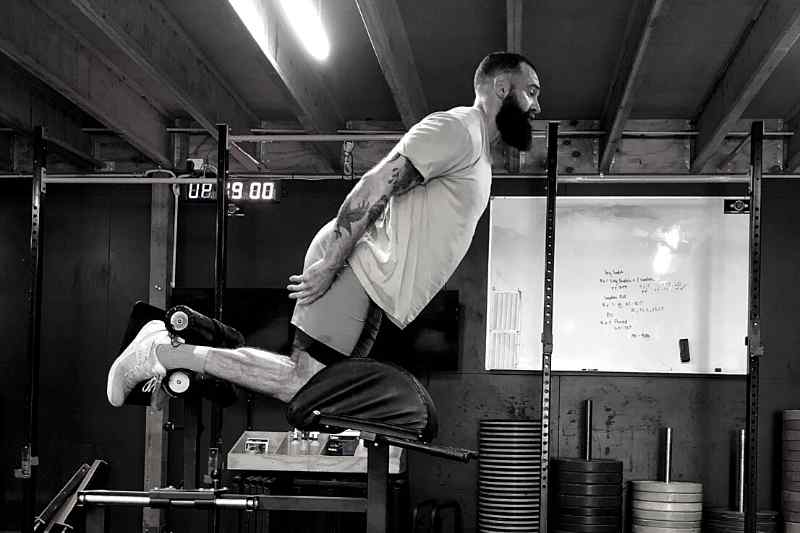
It involves a GHD machine, a specialized piece of equipment that enables you to essentially “curl” your upper body using the strength in your hamstrings and glutes.
To perform this exercise:
- Set up the GHD machine so the pads are resting on your mid-thigh, and your feet are securely pressed against the foot plate.
- Keep your spine straight and cross your arms over your chest.
- Lower until your torso is just below parallel to the floor.
- Use your hamstrings to “curl” your body, pulling it upward and backward. Your knees should slide off the pad and downward. Lift your body until it’s nearly upright.
- Lower under control once more, sliding your knees up and forward onto the pad.
- Repeat as desired.
⭐ Hamstring Exercise #3: Lying Leg Curl
The lying leg curl is an amazing machine-based exercise that will do wonders to engage your hamstrings in a way few other exercises can.
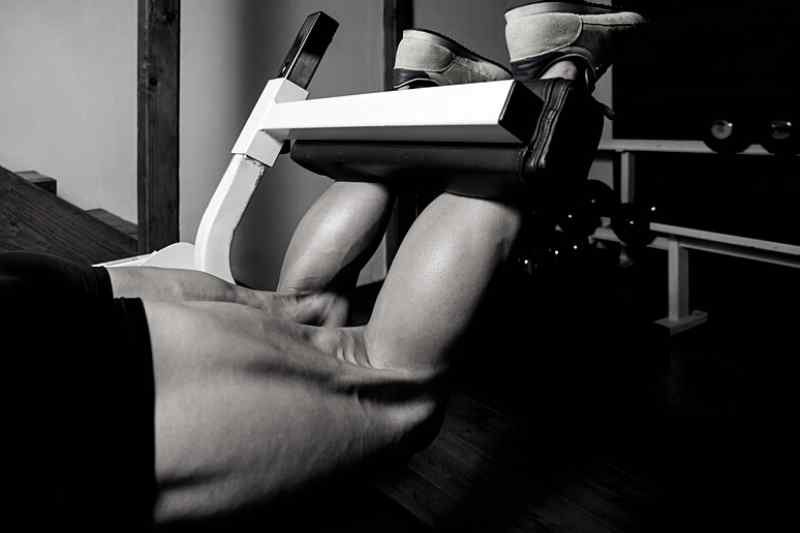
It’s an isolation movement that will put a bit of strain on your knees if you’re not careful, so make sure not to overload or jerk as you perform the curls.
Remember: a slow, smooth movement will lead to results.
To perform this exercise:
- Lie face-down on the leg curl machine. Make sure it’s set so the pad is roughly at ankle level. Set your desired weight.
- Grip the handles and, using only your legs, curl the weight up as close to your butt as possible.
- Control the release as your legs extend—make sure to focus on the eccentric phase as well as the concentric.
- Stop extending just before your legs are fully straight. Keep your hamstrings contracted always.
- Repeat as desired.
⭐ Hamstring Exercise #4: Dumbbell Good Morning
The good morning is a classic lower back exercise that also engages the glutes and hamstrings, but it utilizes a barbell that is placed on your upper back.
With this variation, you’re placing the weight directly in front of you (a dumbbell gripped in your arms) which changes the way your body supports the load. It’s much more hamstring and glute-focused, as well as increasing abs engagement.
To perform this exercise:
- Cradle a dumbbell in your arms, holding the weight against your chest.
- Stand with your feet spread slightly beyond shoulder width apart.
- Hinge backward at the hips, keeping your knees soft and your chest up.
- Lower until your torso is parallel to the ground, maintaining a neutral spine position.
- After a 1-count pause, hinge upwards to return to a standing position.
- Repeat as desired.
⭐ Hamstring Exercise #5: Stability Ball Curl
This exercise is similar in nature to the glute ham raise, in the sense that it involves “curling” your body using your hamstring muscles.
However, you don’t need a GHD machine for this exercise, just a stability ball and your bodyweight. It’s a great no-equipment option for anyone who doesn’t have space in their home gym for a big, fancy machine.
To perform this exercise:
- Lie on your back on a mat or Yoga mat. Place both feet on a stability ball with your legs extended.
- Press your feet into the stability ball and push your body upward as you pull the ball toward your butt. This “curling” movement will engage the hamstrings as well as the glutes, abs, and lower back.
- Lower slowly and under control, and stop just before your butt touches the floor.
- Repeat as desired.
⭐ Hamstring Exercise #6: Single-Leg Stability Ball Curl
Take the difficulty level up a notch by shifting to a one-legged variation of the stability ball curl!
It’ll do an amazing job of engaging your hamstrings one at a time, building better core strength and improving your balance and posture exponentially.
To perform this exercise:
- Lie on your back on a mat or Yoga mat. Place both feet on a stability ball with your legs extended.
- Press your right foot into the stability ball and use it to push your body upward as you pull the ball toward your butt. This “curling” movement will engage the hamstrings as well as the glutes, abs, and lower back. At the same time, lift your left leg high into the air (for extra hip/glute/lower back training).
- Lower slowly and under control, and stop just before your butt touches the floor. Allow your left foot to only barely make contact with the stability ball before lifting it once more.
- Repeat as desired with the right foot, then switch to the left foot to complete the set.
Trainer’s Tip
You can also perform this exercise using a ham/glute slider.
Check out this guide to the best ham glute rollers for building certified hamstrings in the comfort of your own home.
⭐ Hamstring Exercise #7: Kettlebell Swing
Did you know that the kettlebell swing is an amazing exercise for your hamstrings?
The kettlebell swing works the entire posterior chain—shoulders, upper back, lower back, glutes, hamstrings, and calves—to strengthen all the muscles along the back of your body.
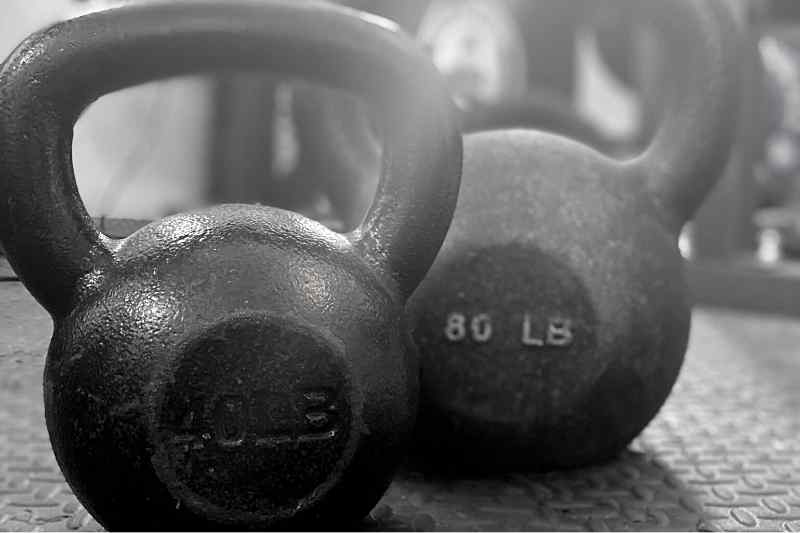
It will even help to improve your hip mobility and ensure more fluid, graceful movement.
To perform this exercise:
- Plant your feet roughly shoulder width apart, with your toes pointed slightly outward. Place your kettlebell of choice between your feet.
- Bend your knees and sink into a squat/sitting position. Grip the kettlebell in both hands.
- Engage your core to lift the weight off the floor and swing it backward.
- As you swing the weight forward, straighten from the squat to a standing position, and swing the weight up to chest level. Keep your glutes, hamstrings, and core tight throughout the entire movement.
- As the weight swings downward, lower into a squat and let the weight swing back toward your butt.
- Repeat as desired.
⭐ Hamstring Exercise #8: Kettlebell One-Legged Deadlift
This is another amazing single-legged exercise that will build real strength in your core while also training your hamstrings.
The instability caused by the one-legged deadlift will do wonders to improve your balance, translating into better posture and form in a wide range of other movements.
To perform this exercise:
- Grip a kettlebell in your right hand. Stand with your feet together, with all of your weight balanced on your right foot.
- Bend forward at the waist, lowering the kettlebell toward the ground. Keep your right leg stiff and straight and extend your left leg out behind you (excellent glute training!).
- Bend until your torso is parallel to the floor, then contract your hamstrings to lift back up to straight. Lower your left leg so your toes lightly touch the floor once you’re standing upright.
- Repeat as desired on the right leg, then switch to the left leg.
⭐ Hamstring Exercise #9: Sumo Deadlift
The sumo deadlift widens your stance to take some of the load off your back and shift it to your hips.
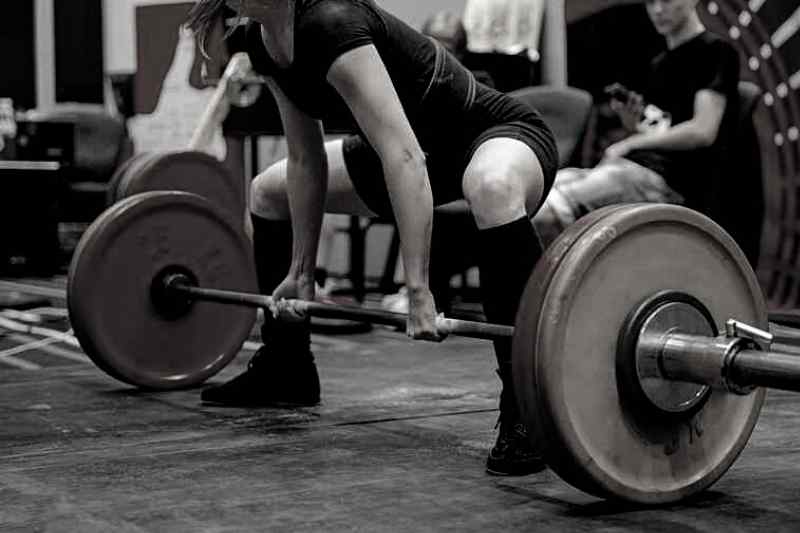
Your hamstrings and glutes also engage to perform the deadlift, making this one of the best hamstring-oriented exercises you can do.
To perform this exercise:
- Stand with your feet spread beyond shoulder width apart, in the “sumo stance”. Aim for the widest stance possible while still being able to comfortably bend and squat.
- Place a barbell on the floor in front of you. Bend at the waist and grip the barbell with your hands between your legs.
- Straighten your upper back and legs to deadlift the weight to a standing position.
- Lower the weight slowly and under control, bending at the knees and hinging the hips backward.
- Repeat as desired.
⭐ Hamstring Exercise #10: Banded Hamstring Curl
If all you’ve got is a pair of resistance bands, you’re good to go!
This exercise is just like lying leg curls, but uses bands instead of a machine.
It’s the perfect at-home solution to help you train those hammies anywhere, anytime.
To perform this exercise:
- Lie on your stomach on a mat or Yoga mat.
- Secure a resistance band to a solid object at one end, and the other end to your right ankle.
- Using only your hamstring muscles, curl the leg upward, pulling it as close to your butt as possible.
- Contract at the top to feel the hamstrings engage to the max, then lower slowly and under control to the ground once more.
- Repeat as desired on the right leg, then switch to the left leg.
20-Minute Hamstring-Focused Workout
Time to put it all together into one glorious workout!
Actually, make that two workouts. There’s no way you can fit all 10 exercises into 20 minutes, we’ve come up with two 20-minute routines you can alternate between to give your legs the maximum training without repeating the same exercises over and over.
Workout #1:
- Kettlebell Swings: 3 sets of 8-12 reps, with 30 seconds of rest between
- Romanian Deadlifts: 3 sets of 8-12 reps, with 30 seconds of rest between
- Kettlebell One-Legged Deadlifts: 3 sets of 8-12 reps, with 30 seconds of rest between
- Lying Leg Curls: 3 sets of 8-12 reps, with 30 seconds of rest between
- Single Leg Stability Ball Curls: 2 sets of 8-12 reps, with 30 seconds of rest between
Workout #2:
- Sumo Deadlifts: 3 sets of 8-12 reps, with 30 seconds of rest between
- Dumbbell Good Mornings: 3 sets of 8-12 reps, with 30 seconds of rest between
- Glute Ham Raises: 3 sets of 8-12 reps, with 30 seconds of rest between
- Banded Hamstring Curls: 3 sets of 8-12 reps, with 30 seconds of rest between
- Stability Ball Curls: 2 sets of 8-12 reps, with 30 seconds of rest between
Hamstring Exercises – FAQs
What is the most effective hamstring exercise?
Romanian deadlifts, lying leg curls, and glute ham raises are all considered “the most effective” exercises for building stronger hamstrings. It’s worth incorporating all three of these bad boys into your Leg Day workout!
How often should you train hamstrings?
Hamstrings should never be overtrained. Your muscles need at least 48 hours of rest between training sessions, or up to 72 hours if the training is very intense (high volume, high intensity).
Ideally, you’ll want to include hamstring training into your Leg Day workouts—either once or twice a week.
We all know the excruciating agony of really sore hamstrings—it feels like someone is stabbing you in the back of the legs each time you take a step.
Focus on progressive overload and don’t overdo it with training your hammies and they will reward you with stronger legs without the crippling soreness that comes from overdoing it.
The Bottom Line
Your hamstrings are incredibly important muscles that play a significant role in your mobility, athletic performance, and agility.
It’s imperative that you take the time to train them regularly.
Using the exercises and workouts listed above will help you pay plenty of attention to these critical muscles so they develop in equal measure to your quads and glutes.
More Articles and Guides Like This
6 Best Glute Exercises for a Stronger and More Muscular Butt (Plus Sample Workout). Strong glutes not only look great, but they are also highly functional. Here are the best glute exercises for a stronger booty. Buckle up for glute gains!
Glute Ham Raises vs. Back Extensions: Pros, Cons and Differences. The glute ham raise and back extension are excellent exercises for hitting your posterior chain. But they differ significantly in muscles worked, injury-risk, and even accessibility. Here’s a detailed comparison including pros and cons of both.